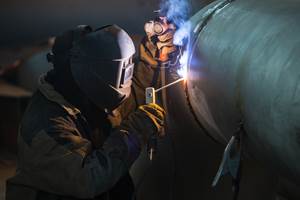Top Ten Tips For Tooling Productivity
Here are 10 suggestions for improving the effectiveness of metalworking processes.
We hold regular tooling-productivity training courses for engineers and programmers who specify tooling. I have been involved in hundreds of these sessions during the past 19 years. Based on the most frequent questions I have heard from students during this time, I have arrived at ten general tips for tooling productivity. Some of these may be old hat to you, but one or two may give you a new insight that might lead to improved metalworking productivity where you work. Here are my "Top Ten" tips:
1. Focus on minimizing the overall machining cost of the part, not just tooling cost. Tooling represents only about 3 percent of total part cost, much less than machine time or machine labor. Follow the real money. Focus on the 97 percent that's all about time and not about tooling price tags.
2. When engineering a new process or troubleshooting an existing one, target four main areas and set clear and measurable goals for each. Those areas are cycle time, tool life, part quality and surface finish. Rank these by priority. Also, share your goals and priorities with your vendors, so they can give you better answers sooner.
3. Understand the forces involved in cutting metal and use these forces to your advantage. Cut in a direction that improves the rigidity of the setup. Consider reducing the depth of cut to convert radial forces into axial forces. Then increase the feed rate to take advantage of the higher axial rigidity.
4. Take advantage of tool geometry to improve throughput. For example, on lead-angle cutters, increase the feed rate to achieve the maximum recommended chip thickness.
5. When troubleshooting, determine whether you have a process problem or a tooling problem. Don't be too quick to blame the tool. Instead, use the mode of tool failure as a clue to the root problem. A chipped edge could indicate use of the wrong carbide grade or excess "play" in the machine or fixture, which would wreck any tool. Look at machine rigidity, feed, speed, depth of cut, presentation angle, chip clearance and coolant. If the problem lies with the tooling, changing the tool will fix it. If the problem lies with the process, it probably won't matter what tool you use.
6. Question the process. Sometimes the right answer is an unconventional approach. On larger holes in one-off or short-run work, milling a hole from solid with helical milling often makes more sense than drilling it, because large-diameter drills are more expensive and less versatile. Another example of an unusual approach that may be worthwhile is plunge milling, which removes material four times faster than slab milling on average.
7. Understand heat—where it comes from and how it can help you or hurt you. Metalcutting will always generate heat, not all of it from friction. When machining steel in particular, you want just enough heat to soften the workpiece material and form good chips. Avoid heat levels that can trigger hardening reactions in the material, overheat the tool or decarburize (crater) the insert.
8. Match tool geometry to the material being cut. Especially in job shops handling a variety of workpiece materials, beware of "general purpose" tooling. Take the time to change tools when you change materials. You'll get more throughput and make more money. Again, the price tag on the tooling is the least important part of the process-economics equation.
9. Plan the cutter path to maximize rigidity and take advantage of higher feed rates.
10. Return to school. Companies that send the same engineers and programmers back to our classes say they see a return on their investment each time. And that return comes fast, usually within weeks of employees completing the class. They come back to the shop excited about applying what they've learned right away. Some of the excitement rubs off on co-workers.
Another reason to return to school is to keep up with what's new in tooling. If you've tooled a job the same way for more than 3 years, odds are that there's a better way that will make you more competitive.
About the author: Dave Eisele is customer training manager for Ingersoll Cutting Tools of Rockford, Illinois.
Related Content
Understanding G27, G28, G29 and G30
Take a closer look at these reference position commands.
Read More8 Ways to Increase Productivity on the Manufacturing Floor
When it comes to machine shop productivity, continuous improvement depends on efficient employees, equipment and processes.
Read MoreSelecting The Right Welder
Many machine shops, on occasion, have a need for welding. It may be for maintenance purposes, repair or to fill the odd contract. This story is a welding process primer for those shops whose main business isn't welding but need to know some basics.
Read MoreUnderstanding The Four Major Behavioral Styles
Companies today are expanding the role of teams in the workplace in an effort to empower employees and improve organizational effectiveness. The more we try to work as a team, the more important it becomes to recognize that people exhibit different behavioral styles.
Read MoreRead Next
3 Mistakes That Cause CNC Programs to Fail
Despite enhancements to manufacturing technology, there are still issues today that can cause programs to fail. These failures can cause lost time, scrapped parts, damaged machines and even injured operators.
Read MoreThe Cut Scene: The Finer Details of Large-Format Machining
Small details and features can have an outsized impact on large parts, such as Barbco’s collapsible utility drill head.
Read More






.jpg;maxWidth=300;quality=90)








.png;maxWidth=300;quality=90)









